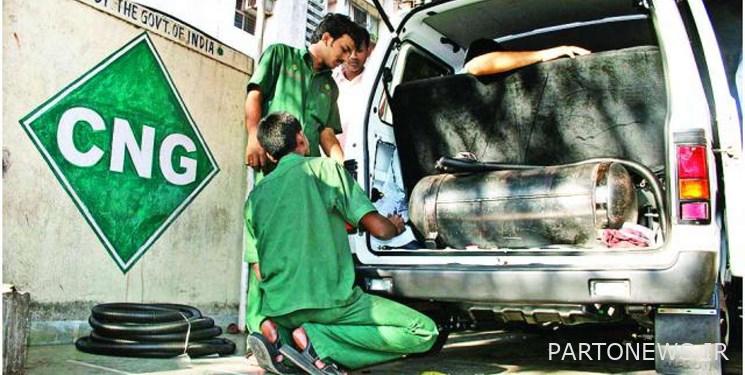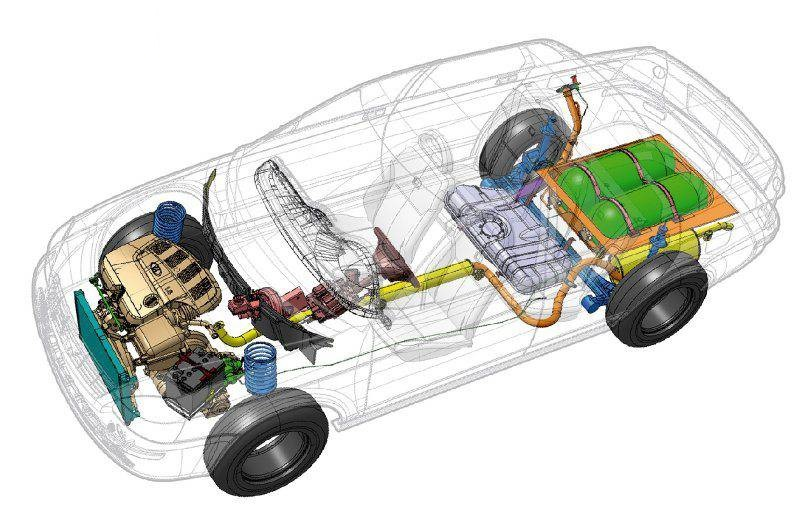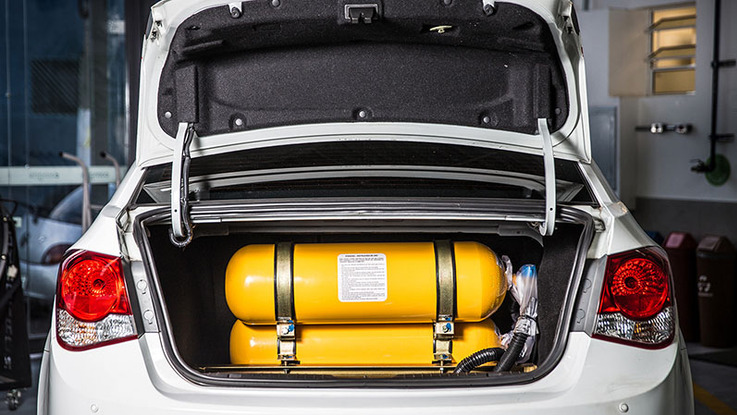National fuel -6 | Strategy to reduce engine depreciation in “gas” vehicles / Development of a new generation of CNG with government support

According to the economic correspondent of Fars News Agency, one of the important priorities of the Ministry of Oil in the 13th government is the development of CNG industry in the country, according to the High Energy Council in the document CNG has emphasized the doubling of its share in the country’s fuel basket.
Currently, the development of CNG in the country is caught in a policy trap, which means that the increase in the share of CNG in the fuel basket is achieved when the price of gasoline increases and the price difference between the two fuels becomes significant, people are motivated to burn CNG cars. On the other hand, due to social considerations, an increase in the price of gasoline will not be possible unless alternative fuels such as CNG have been developed before.
The solution of the Ministry of Oil to solve this policy trap is to implement other policy strategies (other than increasing the price of gasoline) for the development of CNG in the country. In other words, regardless of price issues, there are other challenges in the development of CNG in the country that the government can solve to pave the way for the development of CNG.
* Two proposals to increase the share of CNG in the car fuel basket
One of the challenges is the government’s misguided regulation of quota gasoline for single- and dual-fuel vehicles. At present, the gasoline quota for single-fuel cars is 2-3 times that of dual-fuel cars. Owners of these cars have no incentive to burn their cars CNG due to their significant gasoline quota. As a result, reducing the gasoline quota for single-burner vehicles and considering the equivalent quota for CNG-burning vehicles for them is one of the government’s strategies to support the CNG industry.
Lack of CNG stations in metropolitan areas is also one of the reasons why people are reluctant to use this clean fuel. Government experts believe that by changing the practice of CNG stations in metropolitan areas, the private sector can be encouraged to build stations. Otherwise, the proposal is for the government itself to build CNG stations in metropolitan areas and to create uniformity in the number of stations across the country. It is natural that providing good access to stations encourages people to replace cheap CNG.
* The cost of engine depreciation has offset the economic cost of low CNG prices
But the limited public acceptance of CNG fuel is not limited to “adjusting gasoline prices with inflation since November 1998”, “incorrect government regulation in setting single fuel quotas” and “limited access to CNG stations in metropolitan areas”, and there are other reasons why The use of CNG in people’s calculations has not been so attractive.
In fact, although the low price of CNG compared to gasoline has created a considerable appeal to the public, this economic benefit for car owners is offset by the earlier depreciation of the engine in CNG-burning vehicles.
Javad Nofaresti, oil and energy expert, on the reasons for the lack of widespread acceptance of CNG Says“Perhaps the most important reason for the negative experience of using CNG in gasoline-based vehicles is the high cost of engine and cylinder head wear in CNG-burning vehicles.”
He continued: “For example, studies show that the owners of Iran Khodro products have to pay a heavy cost for the use of CNG for every forty thousand kilometers for the depreciation of the cylinder head. “So the car owner says to himself that it is true that CNG is cheaper than gasoline, but every once in a while I have to pay a lot of money for repairs, which may be more than the total cost of using CNG.”
As a result, in case of incorrect choice of CNG kit type, after conversion, in addition to increasing engine depreciation, power loss will be noticeable and the amount of dual-fuel vehicle emission reduction will be less than expected. This is one of the main reasons for the failure of the free CNG incineration plan approved by the Economic Council in the Twelfth Government.

* What are the advantages and disadvantages of first generation CNG kits?
Gas vehicles are generally produced in two ways:
1- Production in the factory and by the manufacturer (OEM): In this type of dual-fuel vehicle, which is controlled by the ECU (electronic vehicle control unit), the software will take into account all the considerations related to the management of the gas-burning system.
2- Conversion in out-of-factory workshops (After market): This type of dual combustion with the simplest type of parts and was introduced to the market as “first generation”. After reviewing the experts and receiving feedback on improper performance, in the next generations all the experts in different parts of the world over the five decades solved the shortcomings of the first generation and in the second, third and fourth generations improved the performance of the kit.
At present, almost all CNG-burning vehicles in the country have been turned into off-factory workshops with first-generation kits. The use of the first generation of CNG kit technology in these cars has caused the so-called dry CNG car engines to burn and their cylinder heads to wear out and impose exorbitant costs on car owners.
The first generation kit is the simplest CNG system available for spark ignition engines. After leaving the tank, natural gas enters the regulator and after reducing the pressure, it is injected by a mixer in the place before the gas valve or carburetor. The setting is mechanical and manual, and during engine operation there is no feedback on how the fuel and air are mixed, the quality of the combustion and the amount of unburned gases.
The advantages of the first generation of CNG kits can be “simplicity”, “ease of conversion”, “low price”, but this generation has serious disadvantages that due to manual adjustment and the impossibility of changing the gas inlet flow, engine efficiency will be low. Also, the emission reduction is less than expected and the engine power is less than if you use gasoline or 4G CNG kit.
* The 4th generation kit covers the weaknesses of the first generation CNG
After the start of the use of factory gas (OEM) and workshop (After Market) gas systems, significant progress was made to increase efficiency and reduce pollution in gas vehicles in the world, a trend that is tangible and visible in the fourth generation. In the fourth generation (sequential) operation, the natural gas fuel enters the CNG injector after passing through the regulator and reducing the pressure, and will spray the fuel sequentially.
Fuel injection in this system is done near the inlet valve. The program and logic of operation in this system has been the use of fuel injection signals in the gasoline injector. In this way, the signals related to fuel injection in the gas injector will be sent in the same order and proportion to the fuel supply in the gasoline injector.
The biggest advantage of this system is the accuracy of refueling scheduling, and also due to the use of dual-burner main injectors in this generation, it is possible to refuel near the air inlet valve, which will improve efficiency and reduce pollution.
The advantages of the 4th generation kit include highly accurate fuel injection, reduced fuel consumption and reduced emissions. On the other hand, the relatively high price of the 4th generation kit has reduced the general popularity of using this type of kit.
Considering the price in the market for the gas-burning ECU part, the price of this part can be considered about 1.5 million Tomans. If we consider the price of the injector as the same 1.5 million Tomans, in total, the difference between the price of the 4th generation kit with two expensive parts will be about 3 million Tomans compared to the first generation kit.

* Four advantages and one obstacle in the way of using the 4th generation kit for dual-burning cars
In general, the advantages of the 4th generation CNG kit can be mentioned in several cases.
Improved engine output: Due to the differences in the nature of gasoline and natural gas in terms of combustion temperature, lean, rich range and anti-knock property, in the sequential kit, these differences are taken into account in the simulation between gasoline and natural gas program as much as possible and therefore engine output. , In the output power range will be acceptable.
Reduce fuel consumption: Due to the optimization of fuel injection in sequential strategy, compared to the first generation, fuel consumption will be as low as possible and is economically beneficial to the consumer in the long run.
Depreciation reduction: Considering the considerations of adjusting the fuel injection, the ratio of fuel and air in the engine performance in the sequential kit, and considering the type of fuel injection in the first generation, the ratio of fuel and air is sprayed continuously without receiving any feedback. Be, In the first generation kit, due to overheating, as well as cremation and air pressure shocks during operation, the depreciation rate of CNG-involved parts will be higher than the sequential kit. The severity of this problem is such that in the design of gas based engine components, all the necessary changes are made, including improving the thermal resistance and improving the wear resistance.
Pollution reduction: Considering the necessary corrections and the use of oxygen sensor feedback from the combustion quality performed in the sequential kit, the amount of pollution can be considered as the level of pollution produced by the factory. Therefore, the mutual social responsibility of the company and the consumer is well done and in the current situation where respiratory diseases are spreading, this issue will be considered at the community level and for everyone as much as possible.
* The need for government support for the use of 4th generation kits for CNG burning of cars
But to use the 4th generation kit for CNG burning of cars, the price difference of about 3 million Tomans has become a serious challenge. According to the Economic Council, free dual-fueling of cars applies only to first-generation CNG kits, and for 4th-generation kits, the difference must be paid by the car owner himself, which reduces their acceptance of CNG-burning cars.
Given that CNG replaces gasoline and exports equivalent gasoline will generate high foreign exchange earnings for the government, one suggestion is that the 13th government focus its financial support on using the 4th generation kit, although this will cost the government a lot of money. But with the help of the popularity and further development of CNG, this cost will be offset by an increase in gasoline export revenue.
End of message /
.

